| Construction Rating: | starstarstarstarstar_border |
| Flight Rating: | starstarstarstarstar |
| Overall Rating: | starstarstarstarstar |
| Manufacturer: | Qmodeling  |
Brief:
The XP Raptor is a single staged 24mm sport flying semi-scale rocket. I won this rocket in EMRR's recent rocket video
contest where I placed 5th. I thought it only fitting that I try to get it built and a review submitted as soon as
possible especially since it is on the EMRR hit list.
Construction:
The parts list:

- Parachute Compartment C-Ring
- 3x Primary Fins
- Shock Cord Bumper
- Main Nose Cone w/ Eyelet
- Heat Shield
- Nylon Thin-Mil 18" Parachute w/ Shroud Lines
- Upper Main Body Tube
- Snap Swivel
- Kevlar® Shock Cord
- Secondary Fins (3X)
- Launch Lug
- Transition Cone Wrap
- Lower Main Body Tube
- Transition Cone Tab
- Fin Bulkheads (6X)
- FFD Antennas (3X)
- Forward Centering Ring
- Engine Mount Tube
- Transition C-Ring (3X)
- Primary Fins (3X)
- Engine Hook
- Support Brace (3X)
- Fin Brace (3X)
- Thrust Rings (2X)
- Rear Hex Rings (4X)
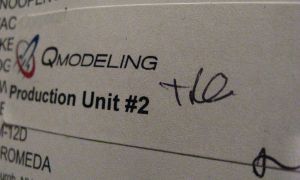
In summary, this is a complicated build. There are a lot of parts so expect to spend some time on it. I found that I spent a lot of time waiting for glue to dry more than anything but that is primarily because on certain steps that called for CA glue I opted for wood glue instead. A handy item to purchase with one of these kits is display stand. During the build it is nice to have a way to hold the motor mount in the vertical to allow glue to dry.
Also, all parts in this build are absolutely top notch materials. I have not seen a kit other than this one where the parts fit together so well. They were snug but rarely too snug. I was also amazed to find the motor mount tube lined with foil. That is awesome, I mean, who does that?
First, the instructions. Even though I did not use the instructions thoroughly like some folks might, I still liked them. There are many words of wisdom within all 23 pages that indicate to me the XP Raptor is made by people with years of rocketry experience. One phrase I took to heart was, "It's a Manual, not a Bible!" Gotta love that.
First step was construction of the motor mount. This called for first cutting a slot for the motor hook to slide in an out. I couldn't see a purpose at the time for doing this I omitted that step. Not a good idea as the slot allows for the motor hook to slide forward enough to allow the Raptor to stand on it's own straight up and down.
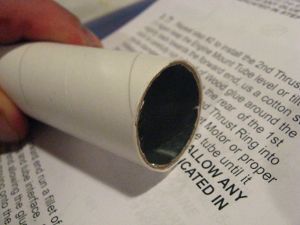
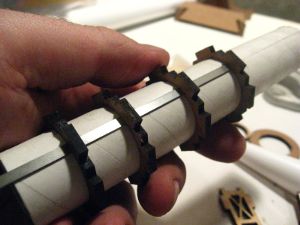
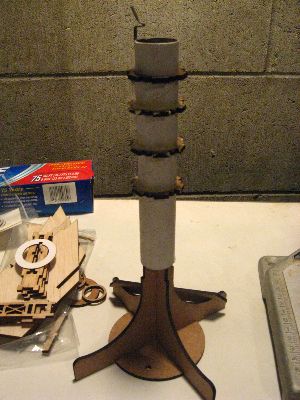
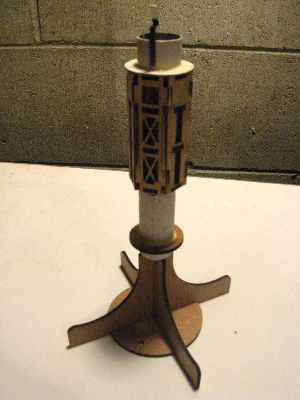
After attaching the motor mount to the lower body tube and affixing the centering rings for the upper body tube came the card-board transition. Again, some words of wisdom from the manual, "Constructing the Transition Cone requires patience and time. Don't attempt construction on a bad day, for example coming home from a miserable day at the office only to find the dog got into the garbage. Take your time and let glue dry throughly. Oh yeah and pet the dog." Good stuff.
The rest of the build is your typical rocket construction. The lower fins slid into place with ease into the pre-cut slots and the lattice work which made alignment a cinch. Follow the instructions carefully for making alignment marks for the upper fins. This is important.
Finishing:
One thing I learned about this kit is that it is far easier to do any desired filling like the tube spirals
before gluing the fins in place. In particular, the fins have these cool little antenna that stick out, but once
they are glued in place, they are a royal pain to work around. This is the only thing I disliked about the build.
While working on the filling I managed to snap a few of the knobs off the antenna. It is important to keep in mind that these knobs are quite delicate.
Construction Rating: 4 out of 5
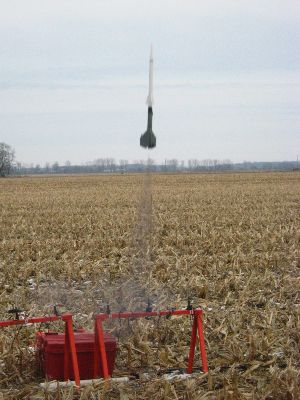
Flight:
For the first flight I used an AT RMS D15-4W. It was at our club launch and the winds were blowing hard at about 20
mph or so. I expected drastic weathercocking, but that was not the case. To my utter surprise, it flew as straight as
an arrow with little to no spin. The second and third flights were on 2/8/09 on E9-6 motors in almost dead calm winds.
Each time the Raptor flew as straight as an arrow.
Recovery:
Recovery is nice on the Raptor. The kit includes a beautiful chute protector and a very nice thin mil nylon chute.
The first flight was when the ground was frozen solid and the fins did sustain some minor damage which could also be
attributed to the high winds I chose to fly in. If flying on very hard surfaces a slightly bigger parachute might be a
wise choice.
Flight Rating: 5 out of 5

Summary:
The main pros are the parts and the performance. I could not have asked for better. A very minor con is the antennas
on the fins. I have managed to break two of them off. One during construction and the other while prepping for flight.
This probably has more to do with my clumsiness than anything else. If I had to build it all over again I would modify
them or leave them off altogether. I do have to admit that they are rather cool looking.
One other word of advice found in the instructions that is particularly important is to not allow this project to become a "glue bomb." Excessive amounts of glue is not going to make this kit stronger. The motor mount configuration with the interlocking fin tabs is inherently strong with small amounts of glue.
Overall Rating: 5 out of 5
Other Reviews
- Qmodeling XP Raptor By Chan Stevens (March 1, 2009)
Brief: With the Raptor, QModeling has ventured away from the mode of upscaling Estes classics and introduced their own design. This one is BT-60 based, tapering to BT-55 with some miltary-style guns/antennae included as well. Construction: I ordered this during their Christmas sale, scoring #25. The kit arrived in 3 days, not too bad during the pre-holiday rush. Parts were ...
 |
 |
Flights
 |
 |
Sponsored Ads
 |
 |












H.C.M. (February 12, 2009)